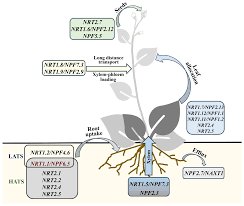New Insights into Nutrient Transport in Plants: The Role of KNS3 Protein

Despite significant advances in understanding how plants uptake and transport nutrients, a key question remains: How are the necessary proteins positioned at the plasma membrane? In particular, plants require boron, absorbed through boric acid channels. A research team led by Professor Junpei Takano at Osaka Metropolitan University's Graduate School of Agriculture has made important discoveries regarding the transport of these channels, focusing on a mutant line of *Arabidopsis thaliana*.
The study identified a mutant in which boric acid channels were not successfully transported to the plasma membrane due to a deficiency in the protein KAONASHI3 (KNS3). This protein’s name, meaning "faceless" in Japanese, was first given by a research team under Nagoya University Associate Professor Sumie Ishiguro in 2008. The current research delves into the transport mechanism of boric acid channels and reveals that KNS3, along with two homologous proteins—KNSTH1 and KNSTH2—form a protein complex crucial for moving these channels from the endoplasmic reticulum to the Golgi apparatus and ultimately to the plasma membrane.
In addition to their role in nutrient transport, KNS3 and its homologs also influence pollen structure. Normally, the pollen of *Arabidopsis thaliana* displays a patterned surface reminiscent of muskmelon skin. However, in mutant strains lacking the KNS3 gene's protein-encoding function, this distinctive pattern disappears, rendering the pollen "faceless." This loss of pattern may indicate abnormal transport of proteins unrelated to the boric acid channel, suggesting a broader role for KNS3 in plant biology.
Professor Takano noted, "Based on the mechanism of intracellular transport of membrane proteins revealed in this study, plants might regulate nutrient uptake and pollen structure by controlling the transport of specific proteins via the KNS3-KNSTH1-KNSTH2 complex. Our findings could provide insights into reducing fertilizer requirements while enhancing crop yields." The research results were published in the *Journal of Experimental Botany*.
Story Source:
Materials provided by Osaka Metropolitan University. The original text of this story is licensed under a Creative Commons License. Note: Content may be edited for style and length.
Journal Reference:
- Zhe Zhang, Shunsuke Nakamura, Arisa Yamasaki, Masataka Uehara, Shunsuke Takemura, Kohei Tsuchida, Takehiro Kamiya, Shuji Shigenobu, Katsushi Yamaguchi, Toru Fujiwara, Sumie Ishiguro, Junpei Takano. Arabidopsis KNS3 and its two homologs mediate endoplasmic reticulum-to-plasma membrane traffic of boric acid channels. Journal of Experimental Botany, 2024; DOI: 10.1093/jxb/erae380

0 Comments